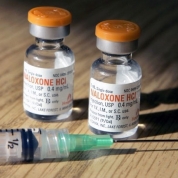Naloxone

Description
Naloxone is used to treat respiratory depression caused by opioids. Opioids produce their effects by acting on opioid receptors in the brain and nervous system. Naloxone works by blocking these opioid receptors, thus stopping opioids from acting on them. This reverses the effects of the opioid primarily in their role as CNS depressants. It is a front-line response against overdose.
Naloxone may be given by injection into a vein, muscle or under the skin, or via a drip into a vein (intravenous infusion).
Rapid Antagonist Induction (RAI) or Ultra Rapid Opiate Detoxification (UROD) is an inpatient procedure currently unavailable on the NHS, that offers the most painless method for coming off opiates yet devised. In short, you are sedated with intravenous or oral anaesthesia and withdrawal is induced by an opiate antagonist (naloxone/ Narcan). Some premedication is taken 12 hours before admission. A range of further medications such as clonidine (a relative of lofexidine) and octreotide (an anti diarrhoea medication) are administered. Although patients are often disorientated on regaining consciousness, most can be discharged within 48 hours of admission, although some units retain patients for five days, only commencing Naltrexone, as ‘blocker’ on around day three.
